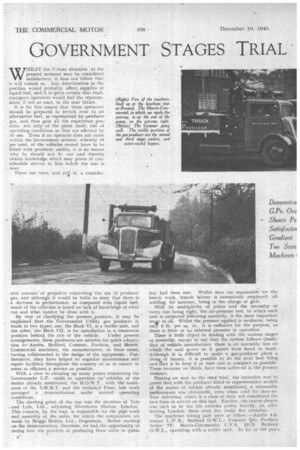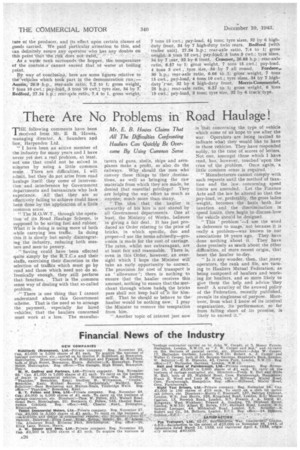GOVERNMENT STAGES TRIAL ITS UTILITY GAS PRODUCER
Page 26

Page 27

Page 28

If you've noticed an error in this article please click here to report it so we can fix it.
WHILST the U-boat situation at the present moment may be considered satisfactory, it does not follow that it will remain so. Any deterioration in the position would probably affect supplies of liquid fuel, and it is quite certain that roadtransport operators would feel the repercussions, if not at once, in the near future.
It is for this reason that these operators 'should be prepared to switch over to an alternative fuel, as represented by producer gas, and thus gain all the experience possible, not onlyof the plant itself, but of operating conditions as they are affected by its use. Even if an operator does not come within the Government scheme, whereby 10 per cent. of the vehicles owned have to be fitted with producer outfits, it is no reason why he should not fit one and • thereby obtain knowledge which may prove of considerable service to him before the war is
over. .
There has been, and still is, a consider able amount' of prejudice concerning the use of producer gas, and although it would he futile to deny that there is a decrease in performance, as compared with liquid fuel, much of the criticism is based on lack of knowledge of what can and what cannot be done with it.
By way of clarifying the present .position, it may he explained that „the Government Utility gas producer is made in two types; one, the Mark VI, is a trailer unit, and the other, the Mark VII, is for installation in a transverse
position behind the cab of the vehicle. Under present arrangements, these producers are suitable for quick adaptation toAustin, Bedford, Commer, Fordson, and MorrisCommercial machines, the manufacturers, in these case-s, having collaborated in the design of the equipment. Furthermore, they have helped to organize maintenance and repair facilities throughout the country so as to ensure to users as efficient a service as possible.
With a view to cleaning up many points concerning the Government G.P. outfit in operation on vehicles of the makes already mentioned, the M.O.W.T., with the assistance of the S.M.:VI.T. and the technical Press, last week arranged a demonstration under normal operating conditions.
The starting point of the run was the premises of Tate . and Lyle, Ltd., adjoining Silvertown Station, London. This concern, by the way, is responsible for the pipe work and assembly of the units, for which the components are made by Briggs"Bodies, Ltd., Dagenham. Before starting on the demonstration, therefore, we had the opportunity of seeing how the problem of producing these units in quan
tity had been met. Whilst Mtn are responsible for the heavy work, female labour is extensively employed, all welding, for instance, being in the charge of girls.
With its multiplicity of joints and the necessity of every bne being tight, the, air-pressure test, to which each unit is subjected following assembly, is the most important state of all. Whilst the pressure applied is moderate, being only 5 lb. per sq. in., it is sufficient for the purpose, as there is little or no internal pressure in operation.
There is little object in dealing with the various stages of assembly, except to say that the system follows 'closely that of vehicle manufacture; there is an assembly line on which the unit grows a's it passes from hand to hand. Although it is difficult to make a gas-producer plant a thing,, of beauty, it is possible to do the next best thing and that is to keep it as neat and as compact as possible. These features, we think, have been achieved in the present instance.
Passing on now to the road trial, the intention was to prove that with the producer fitted to representative models of the makes of vehicle already mentioned, a reasonable performance Was obtainable, even when used for door-todoor deliveries,. which is a clasS of duty not considered the best form of service on this fuel, Farther, the course chosen was such as to tax the vehicles pretty heavily, as, after leaving London, there Were few really flat stretches. "1he machines taking part were as follow :--7-Austin 4-5tonner L.W.B.; Bedford 0.W.L.; Commer QA; Forclson Series 7V; Morris-Commercial C.V.S. 13/ 3; Bedford 0.1.V.L., operating with a trailer unit. So far as the pay-. load was concerned, this consisted of the maximite considered suitable by the vehicle manufacturer, having in mind that the gross load imposed on the road must not exceed the sum of the carrying capacity of the tyres fitted. (The details relative to this feature are given at the end of the article.)
As a,n example, the Morris-Commercial, on which we covered the course, carried a pay-load of 3 tons, the gross load being 6 tons 15 cwt. Whilst this demonstration was not intended as a test of the machines, it may be of interest to mention that the Morris-Commercial was 41 years old and had been running on producer gas for about five months. There was only one trailer outfit in use.
The hopper of each producer was replenished with the GoVernment Utility Progasite fuel, which is anthracite, for which the producer has been designed. Little difficulty was experienced in getting the fuel ignited and, in the case of the MorrisCommercial, it was only four minutes before it was possible to change ovt...to "all gas," .
There are two main controls which the driver has to manipulate with a certain degree of finesse if he is to obtain the best results, and these operate the ignition and the air supply. The air control is the more critical and the driver cannot afford to forget it, particularly when starring.
Early on in the run it was arranged that each vehicle should make six stops, varying item three minutes to seven minutes, within a distance of 1i miles, in order to simulate operating conditions 'such as would be encountered on short-delivery service. Although the law permits the engine being kept running, in the MorrisCommercial we switched off on each occasion, so as to Check up on the powers of recovery of the producer. The results were highly satisfactory, although, naturally, the get-away would have been quicker had we / not stopped the-engine. $.
• The next enforced stop was one of 15 minutes' duration, but, again, there was only momentary hesitation in getting away. We were now coming to long, stiffish climbs, and it is here, perhaps, that one realizes more than at any other time that one is not running on petrol. There is, of course, no suggestion that the engine is going to fail, but road speed comes down and the engine pulls away stoutly, probably on ode gear lower than would be demanded by petrol.
Ahead, however, was the piece de resistance, in the font of a climb of Westerham Hill, with its maximum gradient of 1 in 7. The tOtal length of the climb is one_ mile, and at`eo point does it ease sufficiently to recover engine revs. Of the six vehicles taking part, four needed assistance from the petrol control, but it was only by a small margin that they,failed on producer gas. Whilst each driver felt it his duty to avoid using petrol if possible, the test proved, in rIG uncertain manner, that extraordinarily good performances can be put up on producer gas alone.
The total distance run was 55 miles and no untoward incident occurred throughout.
So far as give-and-take roads are concerned, performance appeared to be little below that obtained on petrol. The snappiness of,,the petrol engine is absent, for which reason, the driver has to adopt a new road technique in that overtaking of other traffic cannot be so freely undertaken. In the actual driving,too, greater .concentration is required, as the best performance is possible only by the intelligent use of the ignition and air controls.
The Morris-Commercial, as already mentioned, has been in service on producer gas for about five months and the driver informed us that, during that period, fuel consumption had worked out at about 1 lb. of fuel per mile, N'o trouble of any kind had been experienced and it was evident that this man had found an entirely new interest in handling a commercial vehicle.
Our general summing up of this trial, as a passenger in the cab of one of the vehicles, is that the use of producer gas is worthy of consideration by all operators and that now is the time to get road experience of it.
A further point, but one which would seem worthy of mentioning, is in connection with the operating tempera ture of the producer, and its effect upon certain classes of goods carried. We paid Particular attention to this, and can definitely assure any operator who has any doubts on this point thatthe risk does not exist.
• As a water tank surrounds the hopper, the temperature of the contain :r cannot exceed that of water at boiling pint.
By way of conclusion, here are some figures relative to the vehicles which took part in the demonstration run:— Austin, 26.3 h.p., rear-axle ratio, 7.2 to 1; gross weight, 7 tons 10 cwt.; pay-load, 3 tons 10 cwt.; tyre size, 34 by 7. Bedford, 27.34 h.p.; rea r-ixle ratio, 7,4 to!, gross weight. 7 tons 15 cwt.; pay-load, 41 tons; tyre sizes, 32 by 6 high. duty front, 34 by 7 high-duty twin rears. Bedford (with trailer unit). 27.34 h.p.; rear-axle ratio, 7.4 to 1; gross weight, 8 tons 13 cwt.; pay load 5 tons 5 cwt.; tyre sizes. 34 by 7 ,ear, 32 by 6 front. Commer, 26.88 h.p.; rear-axle. ratio, 6.57 to 1; gross weight, 7 tons 15 cwt.; pay-load.
4 tons 3 cwt , ,tyre size, 34 by 7 all round. Fordson,. 30 h.p., rear-axle ratio, 6.66 to. 1; gross weight, 7 tons 15 cwt., pay-load, 4 tons 10 cwt.; tyre sizes, 34 by 7 highduty 'par, 32 by 6 high-duty front. Morris-Commercial, 25 h.p.; rear-axle ratio, 6.57 to 1; gross weight, 6 tons '15. cwt,; pay-load, 3 tons; tyre size, 32 by 6 truck type.




















































